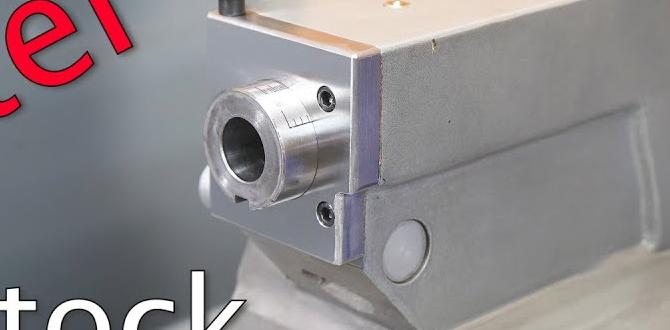Carbide end mills are essential for efficient machining. A 3/16-inch carbide end mill, especially a stub length for Peek, is a fantastic solution for achieving high Material Removal Rates (MRR). This guide will help you understand its benefits and how to use it effectively, making your machining tasks smoother and faster.
Hey everyone, Daniel Bates here from Lathe Hub! Ever feel like your milling projects take forever, especially when working with advanced materials like PEEK? It’s a common frustration, but it doesn’t have to be that way. Many beginners and even experienced makers struggle to find the right tools that can really boost their productivity without causing headaches. Today, we’re going to tackle one of those tricky areas by focusing on a specific, highly effective tool: the 3/16-inch carbide end mill. It might sound small, but this little guy, especially in a stub length for materials like PEEK, is a game-changer for Material Removal Rates (MRR). Stick around, and I’ll break down exactly why it’s so great and how you can start using it to speed up your work and get those impressive results you’re aiming for.
What is a Carbide End Mill and Why 3/16 Inch?
Before we get into the nitty-gritty of achieving high MRR, let’s make sure we’re all on the same page about what a carbide end mill is. Think of an end mill as a rotating cutting tool used in milling machines. It has cutting edges on its tip and sides, allowing it to perform a wide range of operations like slotting, profiling, and contouring. The “carbide” part refers to the material it’s made from – tungsten carbide. This super-hard material is fantastic for cutting tougher metals and plastics because it can withstand high temperatures and wear much better than traditional high-speed steel (HSS) tools.
Now, why the 3/16-inch size specifically? Smaller diameter end mills, like our 3/16-inch friend, offer several advantages, particularly when accuracy and detail are important. They allow for finer cuts, tighter corners, and are often ideal for engraving or creating intricate details within a workpiece. When paired with the right material and machining strategy, a 3/16-inch carbide end mill can be surprisingly capable of high MRR, contrary to what some might assume.
The “Stub Length” Advantage for PEEK
You’ll often see end mills described as “stub length.” What does that mean, and why is it important, especially when machining materials like PEEK? A standard end mill has a certain length of its cutting flute relative to its overall diameter. A stub length end mill is designed with a shorter flute length. This might seem counterintuitive if you’re thinking about removing material quickly. However, for many applications, especially with materials that can be abrasive or a bit gummy like PEEK (Polyetheretherketone – a high-performance thermoplastic), a stub length offers increased rigidity.
This rigidity is key. A shorter, thicker tool (relative to its cutting diameter) will deflect less under cutting forces. Think of it like a shorter, sturdier ruler versus a long, wobbly one. When an end mill is more rigid, it’s less likely to chatter or vibrate. This leads to:”
- Smoother surface finishes.
- More accurate dimensions.
- Ability to take deeper or faster cuts without tool breakage.
- Increased tool life.
For PEEK, which can generate heat and wear down tools quickly, the stability provided by a stub length carbide end mill is invaluable. It allows you to push the tool harder, thus increasing your MRR.
PEEK: The Material and Its Machining Challenges
PEEK is a remarkable material. It’s known for its exceptional mechanical properties, including high strength, stiffness, excellent chemical and hydrolysis resistance, and good wear resistance. These traits make it a popular choice for demanding applications in aerospace, automotive, medical devices, and industrial equipment. However, these same properties present unique challenges for machining:
- Toughness: PEEK can be tough to cut, requiring sharp tools and appropriate cutting forces.
- Heat Generation: It has a relatively low melting point compared to metals. Excessive heat can lead to melting, softening, and poor surface finish. Efficient chip evacuation and cooling are crucial.
- Wear Resistance: While it has good wear resistance in use, PEEK can be abrasive to cutting tools, leading to faster tool wear if the wrong tooling or parameters are used.
- Chip Adhesion: Chips can sometimes stick to the tool or workpiece, leading to recutting and poor surface finish.
All these factors mean that for efficient and successful PEEK machining, you need the right combination of tooling, speeds, feeds, and cutting strategies. This is precisely where our 3/16-inch stub length carbide end mill shines.
Why a 3/16-Inch Carbide End Mill for High MRR in PEEK?
Achieving a high Material Removal Rate (MRR) means cutting material away as quickly as possible while maintaining quality and not damaging the tool or workpiece. For PEEK, a 3/16-inch stub length carbide end mill can be a fantastic solution for several reasons:
- Carbide’s Strength: As mentioned, carbide’s hardness and heat resistance are crucial for consistent cutting, even under demanding conditions.
- 3/16-Inch Diameter: While larger end mills generally have the potential for higher MRR due to their size, a 3/16-inch end mill can be very effective when used correctly on PEEK. Its smaller diameter allows it to be more agile in complex paths and less prone to deflection than a larger, longer tool.
- Stub Length Rigidity: The increased rigidity of a stub length tool allows for more aggressive cutting parameters. You can push it harder, take deeper cuts, or use higher feed rates without sacrificing stability. This directly translates to higher MRR per pass.
- Chip Control: The geometry of a good quality carbide end mill, combined with appropriate machining parameters, helps manage PEEK chips effectively. Proper chip evacuation is vital to prevent melting and tool damage.
- Heat Dissipation: Carbide is good at handling heat. When combined with flood coolant or an air blast, it helps keep the cutting zone cool, preventing PEEK from becoming gummy.
So, instead of thinking you must use a large end mill for high MRR, consider that a smaller, rigid tool can often outperform a larger, flexible one when the material and application call for finesse and stability. The keyword combo “carbide end mill 3/16 inch 1/4 shank stub length for peek high mrr” points to a very specific and powerful combination for achieving exactly this.
Key Features of a Good 3/16-Inch Carbide End Mill for PEEK
Not all end mills are created equal. When you’re specifically looking for a tool to achieve high MRR in PEEK, pay attention to these features:
1. Number of Flutes
The number of cutting edges (flutes) on an end mill affects its performance. For PEEK and other plastics, you generally want fewer flutes. Here’s why:
- 2 Flutes: Excellent for plastics. They provide good chip clearance, which is vital for materials that can melt. They allow for deeper cuts and higher feed rates without clogging.
- 3-4 Flutes: More common for metals. While some high-performance 3-flute end mills have good chip evacuation capabilities for plastics, 2-flute options are often the safer bet for maximum MRR and chip management in PEEK.
For high MRR in PEEK, a 2-flute design is usually the sweet spot. It maximizes the space for chips to escape, leading to cooler cutting and faster material removal.
2. Coating
Many carbide end mills come with specialized coatings. For plastics and composites like PEEK, a coating can:
- Reduce friction and heat buildup.
- Prevent material from sticking to the cutting edge (built-up edge or BUE).
- Increase tool hardness and wear resistance.
Common coatings that perform well on plastics include:
- ZrN (Zirconium Nitride): Offers good lubricity and wear resistance, ideal for non-ferrous materials and plastics.
- AlTiN (Aluminum Titanium Nitride): Though often used for high-temperature alloys, varieties can also work well on certain plastics by offering extreme hardness and heat resistance.
- Uncoated (Polished): For softer plastics, a highly polished, uncoated carbide tool can be very effective, minimizing friction and preventing chip adhesion with its smooth surface.
Always check the manufacturer’s recommendations for which coating is best suited for PEEK. A ZrN coating is often a great starting point.
3. Helix Angle
The helix angle is the angle of the flutes around the body of the end mill. It affects chip evacuation and cutting action. Standard helix angles are typically around 30 degrees.
- High Helix (e.g., 45 degrees): These tools have a steeper spiral. They provide a more shearing cutting action and excellent chip evacuation, which can be beneficial for plastics. However, they can be less rigid and more prone to chatter.
- Standard Helix (e.g., 30 degrees): A good balance between cutting action and rigidity.
For PEEK and high MRR, a specialized plastic-cutting end mill often features a higher helix angle (sometimes called a “high performance” or “fast helix”) to promote aggressive chip evacuation. However, ensure the 3/16-inch size and stub length provide enough rigidity for this steeper angle.
4. End Type
The shape of the tip of the end mill matters:
- Square End: The most common type. It creates sharp internal corners and is versatile for many operations.
- Ball End: Has a hemispherical tip. Used for 3D contouring and creating rounded internal corners.
- Corner Radius: A square end mill with a small radius on the corners. This reinforces the corners, making them stronger and preventing chipping, while still allowing for relatively sharp internal corners.
For high MRR and general profiling/slotting of PEEK, a square end or one with a small corner radius is typically preferred.
Choosing the Right 3/16-Inch Carbide End Mill: Specifications to Look For
Let’s get specific. When you’re hunting for that perfect tool, here are the typical specifications you’ll want to ensure are met:
- Diameter: 3/16 inch (0.1875 inches or 4.76 mm)
- Shank Diameter: Often 1/4 inch (0.25 inches or 6.35 mm) for this size, providing good rigidity for the cutting diameter.
- Length of Cut (LOC): This is the length of the flutes. For stub length, this will be relatively short compared to the shank length.
- Overall Length (OAL): The total length of the tool.
- Material: Solid Carbide.
- Number of Flutes: 2 flutes is ideal for PEEK and high MRR.
- Coating: ZrN or a polished/uncoated variant designed for plastics.
- Helix Angle: Often 30-45 degrees for good chip evacuation.
- End Type: Square or potentially a small corner radius (<0.010")
A specific example search term that includes these details would be: “3/16 carbide end mill 1/4 shank CNC stub length 2 flute ZrN for PEEK”.
Machining Parameters: Getting the Most MRR
Having the right tool is only half the battle. Setting your milling machine up with the correct speeds and feeds is crucial for achieving high MRR safely and effectively with your 3/16-inch carbide end mill on PEEK.
Speeds and Feeds Explained Simply
For our purposes here, think of:
- Spindle Speed (RPM): How fast the end mill spins.
- Feed Rate (IPM or mm/min): How fast the tool moves through the material.
- Depth of Cut (DOC): How deep each pass of the end mill is.
- Width of Cut (WOC): How much of the end mill’s diameter is engaged with the material.
The goal is to find a balance where the tool is cutting efficiently without overheating, chattering, or breaking.
Recommended Parameters for PEEK (Starting Points)
These are general guidelines. Always consult tool manufacturer recommendations and perform test cuts. A good machinist’s handbook or online calculator can be a great resource. For a 3/16-inch (0.1875″) 2-flute carbide end mill on PEEK:
| Parameter | Typical Range for PEEK | Notes |
|---|---|---|
| Spindle Speed (RPM) | 8,000 – 15,000 RPM | Higher speeds are generally better for plastics to generate a good shearing action and flush chips away quickly. |
| Feed Rate (IPM) | 15 – 40 IPM (approx. 380 – 1000 mm/min) | This is highly dependent on DOC and WOC. Start conservatively and increase if conditions allow. Aim for a good chip load. |
| Chip Load per Flute | 0.0005 – 0.001 inch (0.013 – 0.025 mm) | This calculation: Feed Rate / (RPM Number of Flutes). This is critical for preventing plastic from melting into the cut. |
| Axial Depth of Cut (DOC) | 0.0625 – 0.125 inch (1.5 – 3 mm) | For high MRR, you might push this, but always monitor heat and vibration. Stub length helps here. |
| Radial Width of Cut (WOC) | 25% – 50% of tool diameter (e.g., 0.047″ – 0.094″) | For full slotting, WOC is 100% of the tool diameter. For profiling or pocketing, aim for lighter radial engagement to help with chip evacuation. Climb milling is often preferred. |
Important Note on Chip Load: The chip load is perhaps the most critical factor. Chip load is the thickness of the material removed by each cutting edge as it passes through the workpiece. Too small a chip load can lead to rubbing and excessive heat. Too large a chip load can overload the tool. For plastics, a very small chip load is often needed to prevent melting, but a
fast feed rate using this small chip load at high RPMs can still achieve high MRR.Calculating MRR: MRR is roughly calculated as: `Spindle Speed (RPM) Chip Load per Flute Number of Flutes Width of Cut * Depth of Cut`. The goal is to maximize these variables within the tool’s and material’s limits.
Cooling and Lubrication
Machining PEEK effectively often requires good cooling. This helps:
- Prevent melting and softening of the plastic.
- Reduce heat buildup in the cutting tool.
- Help clear chips from the cutting zone.
Options include:
- Flood Coolant: A constant stream of coolant supplied to the cutting area. This is often the most effective.
- Air Blast: Compressed air directed at the cutting zone can help cool and blow chips away.
- Mist Coolant: A fine spray of coolant and air.
For PEEK, a water-based coolant is generally recommended. Avoid oily coolants as they can sometimes react with plastics or create adhesion issues.
Milling Strategies
- Climb Milling vs. Conventional Milling: For PEEK, climb milling is often preferred. In climb milling, the cutter rotates in the same direction as the feed. This results in a thinner chip at the start of the cut and a thicker chip at the end, which helps prevent material buildup on the cutting edge and often gives a better surface finish.
- Stepovers and Plunge Rates: When making multiple passes (e.g., pocketing or profiling), keep stepovers (radial WOC) reasonable. Plunge rates should be significantly slower than your typical feed rate to avoid shock-loading the tool or workpiece.
Achieving High MRR: Practical Tips
Here are some actionable tips to squeeze the most out of your 3/16-inch stub length carbide end mill






